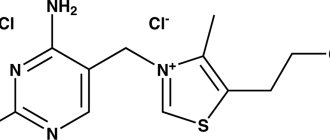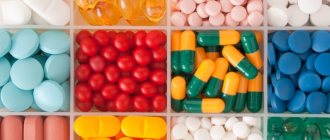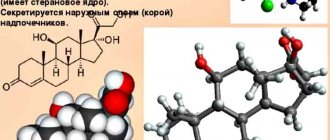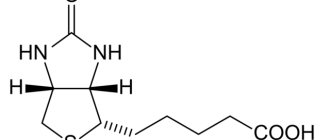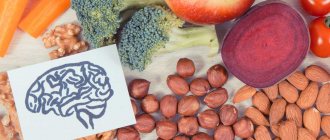Vitamins are substances vital for maintaining the functions of the human body. Therefore, their constant and sufficient presence in the human body, including intake with food, is extremely important.
The biological effect of these substances in the human body consists of active participation in metabolic processes. They either take a direct part or are part of enzyme systems. Vitamins are involved in oxidation processes, as a result of which numerous substances are formed from fats and carbohydrates, which are used as plastic and energy material. They promote cell growth and normal development of the entire body. Vitamins also play an important role in preserving the body’s immunity, ensuring its resistance to the influence of negative environmental factors. This determines the importance of vitamins for the body in the prevention of infectious diseases. Vitamins are also important for restoring the body.
What else are vitamins needed for?
Another function of vitamins is to eliminate or mitigate the adverse effects of many medications on the human body. Their deficiency affects the condition of human tissues and organs, as well as the main functions: growth, physical and intellectual capabilities, procreation, protective functions. A long-term lack of vitamins leads first to a decrease in working capacity, then to a deterioration in health; in the most severe, extreme cases, a lack of vitamins can result in death.
Our body can synthesize individual vitamins only in some cases, and in small quantities.
For example, the amino acid tryptophan can be converted into nicotinic acid. Vitamins are required for the synthesis of hormones - substances that regulate a variety of functions.
Consequently, vitamins are substances that can be classified as essential components of nutrition and that are of paramount importance for the life of the body. Vitamins are necessary for the enzyme and hormonal systems. They also regulate metabolism, making a person cheerful, healthy and beautiful.
The main source of these nutrients is food, and only a few are produced by microorganisms living in the intestines, and even then there are rarely enough of them. Many vitamins are quickly destroyed, so a person needs a constant supply of them.
The use of vitamins for medicinal purposes (vitamin therapy) was initially associated with the impact on various forms of their deficiency. In the middle of the last century, they began to be widely used for fortification of food and feed in livestock farming.
Some vitamins are represented by several related compounds. Knowledge of their structure made it possible to obtain them through chemical synthesis; together with microbiological synthesis, this is the main method of production on an industrial scale. There are also substances similar to vitamins in their structure, the so-called provitamins; entering the human body, they are converted into vitamins. There are also substances that are also close to vitamins in structure, but have the exact opposite effect on the body; they are called antivitamins. This group also includes substances that destroy or bind vitamins. Antivitamins also include some medications, which is further evidence of the dangers of uncontrolled use of medications and self-medication. Now let’s figure out what role individual vitamins play in the body.
What are vitamins and what role do they play in the human body?
Tiny elements, visible only under a microscope, are extremely important for the human body. Once upon a time, a deficiency of just one compound ruined the lives of thousands of people. And another helped to bear healthy, smart children even in unsanitary conditions. There are substances that can be stored in human adipose tissue, and there are those that are eliminated instantly through sweat and water. Read all the secrets of vitamins in our material.
Vitamins are substances that unite a huge group in terms of structure and function, this includes amino acids, fats, and microelements necessary for humans. And everyone contributes to maintaining human health. At the same time, a rare group can be synthesized independently by the body; basically, it must be obtained from tasty and healthy food.
The name of vitamins comes from two words - vita, meaning life, and amine, the ending denoting the combination of substances into one whole group. The nature of the compounds can be simple or complex, organic or chemical. There are artificially derived microelements - products of big chemistry. Growth, development, cell renewal - there is not a single process where these tiny microelements do not play a role.
The importance of individual vitamins
Vitamin A is found mainly in animal products. Liver, butter, eggs and especially fish oil are very rich in this vitamin. Plant foods contain carotene, a substance that is converted into vitamin A. Carrots boast a particularly high content of carotene. Without sufficient vitamin A in food, human growth slows down and eye disease develops. Vitamin A increases resistance to infectious diseases. It is highly soluble in fats and is destroyed by exposure to atmospheric oxygen. It is especially important in the nutrition of children during their first year of life.
Read more about the benefits and harms of carrots for the human body.
B1 is found in vegetables, grain shells, fruits, yeast, milk, animal liver and kidneys. Wheat and rice bran are especially rich in vitamin B1. This vitamin promotes better metabolism, increases the digestibility of food, etc. A lack of this vitamin causes a loss of appetite, a disorder of the nervous system, and rapid fatigue.
Vitamin C is mainly found in fruits and vegetables. Pine, pine needles, rose hips, black currants, green walnuts, and dandelion root are especially rich in it. A lack of vitamin C causes a disease called scurvy. It also strengthens the body's resistance to infectious diseases. This vitamin is soluble in water and is easily destroyed by boiling and exposure to atmospheric oxygen.
Vitamin D is mainly found in products of animal origin, such as egg yolk, caviar, fish oil, milk, butter, etc. It protects the body of children from rickets. Its absence makes bones brittle and has a negative impact on the development of teeth. Vitamin D is fat soluble. It regulates the metabolism of phosphorus and calcium and promotes their deposition in bones. This vitamin is formed under the influence of sunlight and comes from animal products: fatty fish (mackerel, herring, chum salmon, etc.), fish liver, caviar, milk fats, eggs. It is well preserved in processed foods and canned food, and is quite resistant to heat.
Table of vitamins and minerals in foods
A table of vitamins in foods will help you navigate your diet. By adjusting your nutrition plan to your personal needs, you can solve many health problems, such as hair loss, asthenia, nervous exhaustion, fatigue, iron deficiency anemia and many other disorders in the body associated with hypovitaminosis and a lack of certain microelements.
! Attention
: Doses are given in different units of measurement -
grams
(g),
milligrams
(mg) and
micrograms
(mcg). Remember that overdose and hypervitaminosis can be no less dangerous than a deficiency of a particular mineral or vitamin! Remember also that many products (primarily dairy and bakery products) are additionally fortified with vitamins and minerals - read the packaging carefully.
Fat-soluble vitamins are indicated separately in the table as such, since due to the nature of their metabolism, the risk of hypervitaminosis is higher than in the case of water-soluble vitamins.
For convenience, the table is divided by vitamins and microelements. To quickly find the desired microelement or vitamin in the table, use the combination Ctrl + F.
Table of vitamin content in foods
| Vitamin | Product source of vitamin | Functions performed in the body | Recommended daily dose of vitamin | Maximum permissible dose |
| Vitamin A Retinol, as well as carotene – provitamin A | Fish oil, liver, carrots, pumpkin, melon, spinach, cabbage, etc. | Necessary for sharp vision, reproductive function, normal skin condition | Men : 900 mcg/day Women : 700 mcg/day | 3,000 mcg/day |
| Vitamin B1 Thiamine | Whole grain products | Allows the body to process carbohydrates and some proteins. | Men : 1.2 mg/day Women : 1.1 mg/day Pregnant and lactating : 1.4 mg/day | Unknown |
| Vitamin B2 Riboflavin | Milk, bread | Plays a key role in metabolism and energy metabolism; promotes the production of red blood cells | Men : 1.3 mg/day Women : 1.1 mg/day Pregnant : 1.4 mg/day Breastfeeding : 1.6 mg/day | Unknown |
| Vitamin B3 Niacin | Meat, fish, poultry, whole grains | Important for digestion, helps in converting food into energy, participates in the production of cholesterol | Men : 16 mg/day Women : 14 mg/day Pregnant : 18 mg/day Nursing : 17 mg/day | The dose of the vitamin from foods, not limited, from fortified foods – 35 mg/day |
| Vitamins B4 Choline | Milk, liver, eggs, peanuts | Plays a key role in the production of cells and neurotransmitters - substances that transmit signals along nerve endings | Men : 550 mg/day Women : 425 mg/day Pregnant : 450 mg/day Nursing : 550 mg/day | 3,500 mg/day |
| Vitamin B5 Pantothenic acid | Chicken, beef, potatoes, oats, tomatoes, grain products | Important for fatty acid metabolism | Adults : 5 mg/day Pregnant : 6 mg/day Nursing : 7 mg/day | Unknown |
| Vitamin B6 Pyridoxine | By-products | Important for the functioning of the nervous system; Helps in protein and glucose metabolism | Men 19-50 : 1.3 mg/day Men over 51 : 1.7 mg/day Women 19-50 : 1.3 mg/day Women over 51 : 1.5 mg/day Pregnant : 1.9 mg/day Breastfeeding : 2 mg/day | 100 mg/day |
| Vitamin B7 Biotin | By-products (liver), meat, fruits | Helps in metabolism – synthesis of fats, glycogen and amino acids | Adults : 30 mcg/day Nursing : 35 mcg/day | Unknown |
| Vitamin B9 Folic Acid | Dark leafy vegetables | Important for the development of all types of cells, protein metabolism, and heart health. Helps prevent fetal malformations during pregnancy | Adults : 400 mcg/day Pregnant : 600 mcg/day Nursing : 500 mcg/day | 1,000 mcg/day |
| Vitamin B12 Cobalamin | Fish, meat, poultry | Participates in the production of red blood cells | Adults : 2.4 mcg/day Pregnant : 2.6 mcg/day Nursing : 2.8 mcg/day | Unknown |
| Vitamin C Ascorbic Acid | Bell pepper, kiwi, citrus fruits, broccoli | Antioxidant that protects cells from damage; strengthens the immune system; participates in collagen synthesis | Men : 90 mg/day Women : 75 mg/day Pregnant : 85 mg/day Nursing : 120 mg/day | 2,000 mg/day |
| Vitamin D Calciferol | Fats from fish liver, fatty fish, are synthesized in the body under the influence of ultraviolet radiation | A fat-soluble vitamin that is involved in calcium metabolism, ensuring bone health and bone density. | Adults 18-50 : 5 mcg/day Adults 51-70 : 10 mcg/day Adults over 70 : 15 mcg/day | 50 mcg/day |
| Vitamin E Tocopherol | Sunflower seeds, almonds, peanut and vegetable oils | Fat-soluble vitamin. Antioxidant that protects cells from damage; important for reproductive function | Adults : 15 mg/day Nursing : 19 mg/day | 1,000 mg/day |
| Vitamin K | Green leafy vegetables (spinach, broccoli, Brussels sprouts and kale) | One of the few fat-soluble vitamins in the table. Essential for blood clotting and bone health. | Men : 120 mcg/day Women : 90 mcg/day | Unknown |
Table of mineral content in foods
| Mineral | Product source of mineral | Functions in the body | Recommended daily dose | Maximum permissible dose |
| Calcium (Ca) | Milk, yogurt, hard cheese, and other dairy products; green leafy vegetables (spinach). | Indispensable for the growth and strength of bones, blood clotting, muscle contractions, and the transmission of nerve signals. | Adults 19-50 years old : 1,000 mg/day Adults over 51 years old : 1,200 mg/day | 2,500 mg/day |
| Chromium (Cr) | Meat, poultry, fish, some grains | Helps control blood glucose levels | Adult men 19-50 years : 35,300 mcg/day Adult men 51 years and older : 30,300 mcg/day Adult women 19-50 years : 25,300 mcg/day Adult women 51 years and older : 20,300 mcg/day Pregnant women : 30,300 mcg/day Nursing : 45,300 mcg/day | Unknown |
| Copper (Cu) | Seafood, nuts, seeds, wheat bran, cereals, whole grains | Participates in iron metabolism | Adults: 900 mcg/day Pregnant: 1,000 mcg/day Nursing: 1,300 mcg/day | 10,000 mcg/day |
| Fluorine (F) | Fluoridated water, some saltwater fish, and some toothpastes and mouthwashes | Prevents tooth decay and stimulates bone growth | Adult men : 4 mg/day Adult women : 3 mg/day | 10 mg/day |
| Iodine (I) | Specially prepared food, iodized salt, water | Participates in the synthesis of thyroid hormones | Adults : 150 mcg/day Pregnant : 220 mcg/day Nursing : 290 mcg/day | 1,100 mcg/day |
| Iron (Fe) | By-products, legumes, beef, eggs | Iron-containing hemoglobin is a key element of red blood cells. Iron is a component of many enzymes | Men : 8 mg/day Women 19-50: 18 mg/day Women over 51 : 8 mg/day Pregnant : 27 mg/day Breastfeeding : 9 mg/day | 45 mg/day |
| Magnesium (Mg) | Green leafy vegetables; nuts – especially almonds, Brazil nuts, soybeans | Normalizes heart rate; important for the nervous system, muscle function and bone strength | Men 19-30 : 400 mg/day Men 31 and older : 420 mg/day Women 19-30 : 310 mg/day Women over 31 : 320 mg/day Pregnant : 350-360 mg/day Nursing : 310-320 mg/ day | The mineral obtained from products is not limited. If source is supplements or fortified foods – 350 mg/day |
| Manganese (Mn) | Nuts and legumes, tea, whole grains | Important for bone formation and the production of a number of enzymes | Men : 2.3 mg/day Women : 1.8 mg/day Pregnant : 2.0 mg/day Breastfeeding : 2.6 mg/day | 11 mg/day |
| Molybdenum (Mb) | Legumes, grains, nuts | Extremely important for the synthesis of a number of enzymes | Adults : 45 mcg/day Pregnant and breastfeeding : 50 mcg/day | 2,000 mcg/day |
| Phosphorus (Ph) | Milk and dairy products, peas, meat, eggs, some cereals and breads | Plays a key role in bone growth. Supports cell functions, participates in the body's energy metabolism | Adults : 700 mg/day | Adults up to 70: 4,000 mg/day Adults over 70 : 3,000 mg/day Pregnant : 3,500 mg/day Nursing 4,000 mg/day |
| Potassium (K) | Bananas, yoghurts, potatoes with peel, citrus fruits, soybeans | Responsible for normal water-electrolyte metabolism; helps control blood pressure; reduces the risk of kidney stones | Adults : 4,700 mg/day Nursing : 5,100 mg/day | Unknown |
| Selenium (Se) | Meat and seafood, some plants grown in soil enriched with selenium; brazil nuts | Regulates the activity of thyroid hormones; protects cells from free radical damage | Adults : 55 mcg/day Pregnant : 60 mcg/day Nursing : 70 mcg/day | 400 mcg/day |
| Sodium (Na) | As an additive during cooking | Important for water and electrolyte balance | Adults 19-50 : 1,500 mg/day Adults 51-70 : 1,300 mg/day Adults over 71 : 1,200 mg/day | 2,300 mg/day |
| Zinc (Zn) | Red meat, some seafood | Supports immunity, nervous system, reproductive function | Men : 11 mg/day Women : 8 mg/day Pregnant : 11 mg/day Nursing : 12 mg/day | 40 mg/day |
Why do you need a table of vitamins and minerals?
Scientists agree that it is best to get your vitamins and minerals from foods rather than pills. However, when we say that we get so many vitamins and minerals from such and such a product, we do not know for sure exactly how much of a particular biologically active substance we need.
| Cellulose | Cereals, cereals and legumes. Fruits and vegetables | Normalizes digestion and blood sugar levels; reduces the risk of cardiovascular diseases | Men 19-50 years old : 38 g/day Men over 51 years old : 30 g/day Women 19-50 years old : 25 g/day Women over 51 years old : 21 g/day Pregnant women : 28 g/day Nursing : 29 g/day |
Our table will help you determine the necessary vitamins and micro- and macroelements, their sources, as well as the daily dose of each nutrient that your body needs. Based on the table of vitamins and microelements, you can build diets, nutrition programs, monitor the condition of the skin, hair and general tone of the body.
It would also be appropriate to remember about fiber - dietary fiber, which is neither a vitamin nor a mineral, and, in fact, has no nutritional value. However, due to its functions as a filler and sorbent, fiber is an indispensable element of a healthy diet for any person.
What are vitamins and what role do they play in the human body?
Tiny elements, visible only under a microscope, are extremely important for the human body. Once upon a time, a deficiency of just one compound ruined the lives of thousands of people. And another helped to bear healthy, smart children even in unsanitary conditions. There are substances that can be stored in human adipose tissue, and there are those that are eliminated instantly through sweat and water. Read all the secrets of vitamins in our material.
Vitamins are substances that unite a huge group in terms of structure and function, this includes amino acids, fats, and microelements necessary for humans. And everyone contributes to maintaining human health. At the same time, a rare group can be synthesized independently by the body; basically, it must be obtained from tasty and healthy food.
The name of vitamins comes from two words - vita, meaning life, and amine, the ending denoting the combination of substances into one whole group. The nature of the compounds can be simple or complex, organic or chemical. There are artificially derived microelements - products of big chemistry. Growth, development, cell renewal - there is not a single process where these tiny microelements do not play a role.
Antioxidant function
A radical is a highly reactive oxygen molecule that does not have an electrode and tends to take it away from a full-fledged molecule. Exceeding the permissible amount of free radicals leads to rapid aging of people.
Antioxidants are a group of synthetic or biological substances that protect humans from the destructive effects of free radicals. Vitamins A, E, C and carotene have antioxidant properties.
Chicken
The best sources of vitamin B from chicken are poultry by-products: liver, gizzards and hearts. Chicken meat is low in calories and easily digestible compared to other types.
You can get the most vitamins B3, B5 and B6 from chicken.
The best heat treatment for such meat is boiling or baking with a small amount of oil. It is worth giving up the chicken offered by modern fast food restaurants. Deep-fried chicken meat is not able to bring beneficial substances to the body, but contains a large number of carcinogens that negatively affect health.
The content of other useful substances in chicken food products is also at a high level: vitamins A and C, minerals phosphorus, sodium, potassium, calcium, iron, etc.
Regulation of vital processes
They take part in all processes in vital organs and systems. The main functions of vitamins of various groups:
- B1, B3, B6, B12 are involved in the regulation of the central nervous system;
- A-group improves heart function, hair and skin condition;
- the function of vitamins C and B is to form and maintain the skeletal system;
- A, E, B2 are responsible for the normal functioning of the lungs;
- A, C, D are necessary to maintain dental health;
- And the vitamin improves vision;
- B and C have a positive effect on the functioning of blood vessels.



